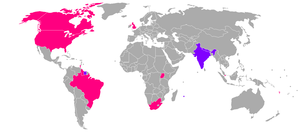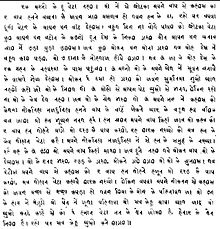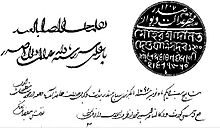- Bhojpuri language
-
Bhojpuri भोजपुरी bhōjapurī 
The word "Bhojpuri" in Devanagari scriptSpoken in India, Nepal, Mauritius, Suriname
moribund in Guyana and Trinidad and Tobago
Region Nepal, Bihar, Uttar Pradesh, Jharkhand Native speakers 38.5 million (1997) Language family Indo-European- Indo-Iranian
- Indo-Aryan
- Eastern Group
- Bihari
- Bhojpuri
- Bihari
- Eastern Group
- Indo-Aryan
Dialects Caribbean Hindustani, Sarnami, Mauritian BhojpuriWriting system Devanagari, Kaithi Language codes ISO 639-1 bh (Bihari languages) ISO 639-2 bho ISO 639-3 bho Linguasphere 59-AAF-sa  Countries where Bhojpuri is spoken.
Countries where Bhojpuri is spoken.This page contains IPA phonetic symbols in Unicode. Without proper rendering support, you may see question marks, boxes, or other symbols instead of Unicode characters. Bhojpuri (
 pronunciation (help·info)) is a language spoken in parts of north-central and eastern India. It is spoken in the western part of state of Bihar, the northwestern part of Jharkhand, and the Purvanchal region of Uttar Pradesh (UP), as well as adjoining parts of the Nepal Terai.[1] Bhojpuri is also spoken in Guyana, Suriname, Fiji, Trinidad and Tobago and Mauritius. The variant of Bhojpuri of the Surinamese Hindustanis is also referred to as Sarnami Hindustani, Sarnami Hindi or just Sarnami and has experienced considerable Creole and Dutch lexical influence. More Indians in Suriname know Bhojpuri compared to Guyana and Trinidad where the language is largely forgotten.
pronunciation (help·info)) is a language spoken in parts of north-central and eastern India. It is spoken in the western part of state of Bihar, the northwestern part of Jharkhand, and the Purvanchal region of Uttar Pradesh (UP), as well as adjoining parts of the Nepal Terai.[1] Bhojpuri is also spoken in Guyana, Suriname, Fiji, Trinidad and Tobago and Mauritius. The variant of Bhojpuri of the Surinamese Hindustanis is also referred to as Sarnami Hindustani, Sarnami Hindi or just Sarnami and has experienced considerable Creole and Dutch lexical influence. More Indians in Suriname know Bhojpuri compared to Guyana and Trinidad where the language is largely forgotten.Bhojpuri is part of the Eastern-Hindi or Bengali continuum of languages which once extended from Assam and Bengal to Ballia. While the rest of Bihar and Uttar Pradesh slowly adopted the new Hindi standard (Khadi Boli), the language remained strong in the areas between Patna and Benaras.Some scholar trace the literacy history of Bhojpuri from Siddha Sahitya itself, as early as 8th century A.D. Kabir’s contribution of ‘nirgun’ poetry to Sant Sahitya certainly qualifies as recorded literature in Bhojpuri in the 15th century.The nineteenth century has such works as Deviksaracarita by Ramdatta Shukla (1884), Badmasdarpan by Teg Ali Teg (1895), and Jangal me Mangal and Nagari Vilap by Ram Garib Chaube in the later half of the nineteenth century.
The scholar, polymath and polyglot Mahapandit Rahul Sankrityayan wrote some works in Bhojpuri.[2] Other eminent writers include Viveki Rai. The number of Bhojpuri writers is small compared to the number of speakers. Some other notable Bhojpuri personalities are legendary freedom fighter Swami Sahajanand Saraswati, first president of India Rajendra Prasad, Manoj Bajpai, and former Indian prime ministers Lal Bahadur Shastri and Chandra Shekhar. Bihar Kokila Padma Shri Sharda Sinha is a famous Bhojpuri folk singer.Contents
Number of speakers
According to an article published in Times of India, a total of 150 million people in India speak Bhojpuri. An estimated 70 million people in Uttar Pradesh and 80 million people in Bihar speak Bhojpuri as their first or second language. There are 6 million Bhojpuri speakers living outside of Bihar and Purvanchal. These areas include Nepal, especially Birgunj, Mauritius, Fiji, Suriname, Guyana, Uganda, Singapore, Trinidad and Tobago, Saint Vincent and the Grenadines, the United Kingdom, the Netherlands, Canada, and the United States. This makes the total Bhojpuri speaking population in the world close to 90 million.[1] However, the official figures of the 2001 Indian Census are much lower, showing 33 million speakers of the Bhojpuri dialect under the Hindi language sub-family.[3]
Bhojpuri dialects, varieties, and creoles are also spoken in various parts of the world, including Brazil, Fiji, Guyana, Mauritius, South Africa, Suriname, and Trinidad and Tobago. During the late 19th century and early 20th century, many colonizers faced labor shortages and were unable to obtain slaves from Africa due to the abolition of slavery; thus, they imported many Indians as indentured servants to labor on plantations. Today, many Indians in the West Indies, Oceania, and South America still speak Bhojpuri as a native or second language.
The Bhojpuri language has been heavily influenced by other languages in many parts of the world. Mauritian Bhojpuri includes many Creole and English words, while the language spoken in Trinidad and Tobago includes Caribbean and English words.
The Sunday Indian, Bhojpuri Association of India and Global Bhojpuri Movement has launched a worldwide movement for the Recognition, Promotion and Preservation of Bhojpuri Language, Art, Culture, Literature and society.
Bhojpuri literature
The Bhojpuri-speaking region, due to its rich tradition of creating leaders for building post-independence India such as first President Dr. Rajendra Prasad followed by many eminent politicians and humanitarians like Dr. Krishna Dev Upadhyaya, was never devoid of intellectual prominence which is evident in its literature.
Bhojpuri became one of the bases of the development of the official language of independent India, Hindi, in the past century. Bhartendu Harishchandra, who is considered the father of literary Hindi, was greatly influenced by the tone and style of Bhojpuri in his native region. Further development of Hindi was taken by prominent laureates such as Mahavir Prasad Dwivedi and Munshi Premchand from the Bhojpuri-speaking region. Bhikhari Thakur, known as the Shakespeare of Bhojpuri, has also given theater plays including the classics of Bidesiya. Pioneer Dr. Krishna Dev Upadhyaya from Ballia district devoted 60 years to researching and cataloging Bhojpuri folklore. Dr. H. S. Upadhyaya wrote the book Relationships of Hindu family as depicted in Bhojpuri folksongs (1996). Together they have cataloged thousands of Bhojpuri folksongs, riddles and proverbs from the Purvanchal U.P, Bihar, Jharkand and Chotta Nagpuri districts near Bengal.
The Bhojpuri literature has always remained contemporary. It was more of a body of folklore with folk music and poems prevailing. Literature in the written form started in the early 20th century. During the British era, then known as the "Northern Frontier Province language", Bhojpuri adopted a patriotic tone and after independence it turned to community. In later periods, following the low economic development of the Bhojpuri-speaking region, the literary work is more skewed towards the human sentiments and struggles of life.
A recent publication (2009) 'Bhojpuri-Lok Sahitya: Lok Geeton Ki Samajik Sanskritik Sandarbh Evam Prishthbhumi" (Bhojpuri Folk Literature: Social and Cultural Landscape of Folk Songs) by Dr. Dharmveer Singh (Publisher: Chaukhamba Sanskrit Bhavan, P.O. Box 1160, Chowk, Varanasi-221001, India) contains an exhaustive research on the historical and social background of the origin and temporal development of this language in greatest detail. This book is exhaustive in its approach and is a gem for anyone who is interested in Bhojpuri as a language. The most impressive aspect of the book is the collection of folk-songs that the author has gleaned from various sources. With the advent of modern technology and effect of cinema, these folk-songs are becoming extinct. This book preserves not only the songs in a written form but also provides the context in which they should be viewed and appreciated.
- Bhojpuri Writers-Viveki Rai Is a famous Bhojpuri writer.
Writing scripts
Bhojpuri over the course of time has been written in various scripts by various people. Bhojpuri until late 19th century was commonly written in Kaithi script as well as Nasta'liq (Persian) script.
Kaithi
Kaithi script was used for administrative purposes in the Mughal era for writing Bhojpuri, Maithili, Bangla, Urdu, Magahi and Hindi from at least 16th century up to the first decade of 20th century. Government gazetteers report that Kaithi was used in a few districts of Bihar through the1960s.It is possible that Kaithi is still used today in very limited capacity in these districts and in rural areas of north India. The significance of Kaithi grew when the British governments of the Bengal Presidency (of which Bihar and some southern districts of Nepal was territory) and the NorthWestern Provinces & Oudh (hereafter, NWP&O) selected the script for use in administration and education. The first impetus of growth was the standardization of written Kaithi in 1875 by the government of NWP&O for the purpose of adapting the script for use in formal education. The second was the selection of Kaithi by the government of Bihar as the official script of the courts and administrative offices of the Bihar districts in1880.Thereafter; Kaithi replaced the Persian script as the writing system of record in the judicial courts of Bihar. Additionally, on account of the rate of literacy in Kaithi, the governments of Bihar and NWP&O advocated Kaithi as the medium of written instruction in their primary schools.
Nasta'liq (Persian)
Before 1880 all the administrative works in Bihar was done in this Persian script and possibly all the educated Muslims in the Bhojpuri speaking region wrote unofficial works in Nasta'liq script.
Devanagari
By 1894, official works were carried out in both Kaithi and Devanagari in Bihar which probably started giving way to replacement of Kaithi completely by Devanagari. At present almost all the Bhojpuri works are done in Devanagari even in the overseas islands where Bhojpuri is spoken.
Bhojpuri Media
- In Bhojpuri many magazine and papers published from U P, Bihar West Bengal & Assam. The Sunday Indian, Bhojpuri is world's only regular National News Magazine in Bhojpuri published by Planman Media, owned by Prof. Arindam Chaudhary and Edited by Onkareshwar Pandey. Sanesh this is a first quarterly magazine from north east Guwahati. Bhojpuri Lok Lucknow[4]
- Mahuaa TV and Hamar TV are the Bhojpuri Channel.
Phonology
Bilabial Labio-
dentalDental/
AlveolarRetroflex Post-alv./
PalatalVelar Uvular Glottal Nasal m n (ɳ) Plosive p
pʰb
bʱt̪
t̪ʰd̪
d̪ʱʈ
ʈʰɖ
ɖʱk
kʰɡ
ɡʱq Affricate tʃ
tʃʰdʒ
dʒʱFricative f s z ʃ x ɣ ɦ Tap or Flap ɾ (ɽ)
(ɽʱ)Approximant ʋ l j Bhojpuri speakers not acquainted with Hindi or Urdu would generally not be able to pronounce many of the above phonemes. The phonemes /q/, /x/, /ɣ/, /z/ and /f/ are not pronounced by most Bhojpuri-speakers, as they are loans from Persian.
Furthermore the labio-dental approximant /ʋ/ (va) is often realized as [b] (ba), while the palatal fricative /ʃ/ (sha) and the retroflex Fricative /ʂ/ (sha) are merged with /s/ by many speakers.
Comparison of Dialects of Bhojpuri
Bhojpuri has three dialects identified in the literature as
1- Standard Bhojpuri (also referred to as Southern Standard), 2- Northern Bhojpuri, 3- Western Bhojpuri
Southern Standard Bhojpuri covers the areas of Bhojpur, Rohtas, Saran, Bhabua, Buxar, Siwan, Gopalganj in Bihar, and Ballia and eastern Ghazipur in Uttar Pradesh. One may also come across a local name ‘Chaparahiya’ in Saran.
Northern Bhojpuri covers the areas of Deoria, Gorakhpur and Basti in Uttar Pradesh and parts of Champaran in Bihar. Local names include ‘Gorakhpuri’ for the language in Deoria and eastern Gorakhpur, and ‘Sarwariya’ in western Gorakhpur and Basti. The variety spoken cast of Gandak river between Gorakhpuri Bhojpuri and Maithili in Champaran has a local name Madhesi.
Western Bhojpuri includes the areas of Varanasi, Azamgarh, Ghazipur and Mirzapur in Uttar Pradesh ‘Banarasi’ is a local name for the Banaras Bhojpuri. There is a very popular general name ‘ Purabiya’ for (curiously enough) Western Bhojpur, obviously used by Hindi speakers to the west of them.
Bhojpuri in Nepal
Bhojpuri is spoken by at least 2.5 million people in Nepal (9% of the total population of Nepal), the districts categorised as Bhojpuria districts lying between the Mithilanchal and Awadh regions of Nepal are: Rautahat, Bara, Parsa, Chitwan, Nawalparasi and Rupandehi. As people from hills have migrated in large numbers to these districts the native Bhojpuri language is suffering from adulteration and as Nepali has been imposed on people of these regions, most of the adulteration is due to Nepali language. However, the Nepali speakers in this region have somehow become modest speakers of Bhojpuri and can understand Bhojpuri quite well. And due to similarity, Maithili and Awadhi speakerscan also understand Bhojpuri quite well. Total Number of People who can understand the language in Nepal exceeds 12 million however who speak it as first or second tongue are around 4 million.
Some of the very popular local Radio stations in this region have been broadcasting news and entertainment materials in Bhojpuri, although due to Nepali speakers speaking bhojpuri in these radio stations, Bhojpuri sometimes appears awkward. Some of the popular radio stations for Bhojpuri are : Gadhimai FM, Indreni FM, Bijay FM, Rupandehi FM, Samyak FM, Radio Birgunj, Narayani FM and others are in the pipeline such as : Masti FM, Nobel FM, Kadambari FM, Rautahat FM, Gaur FM, Radio Namaste and Madhyabindu FM.
In Kathmandu, Music FM broadcasts Bhojpuri songs and some daily programmes in the language.
Radio Nepal, the state controlled radio broadcasts daily news in Bhojpuri at 6:05 PM local time daily. Above that, the state controlled Nepal Television 2 shows weekly Bhojpuri cultural programmes.
There are at least 5 Bhojpuri Newspapers being circulated on regular basis in this region.
See also
- Hindustani language
- Bhojpuri cinema
- Languages with official status in India
- List of Indian languages by total speakers
- List of Bhojpuri poets
- Languages of Nepal
Notes and references
- ^ Detailed language map of western Nepal, see disjunct enclaves of language #9 in SE
- ^ Sharma, R.S. (2009). Rethinking India's Past. Oxford University Press. ISBN 978-0195697872.
- ^ Census of India 2001
- ^ https://rni.nic.in/display_language.asp
Angika · Bhojpuri · Fiji Hindi · Kudmali · Magahi · Maithili · Majhi · Musasa · Panchpargania · Sadri · Sadri, Oraon · Sarnami Hindustani · Surajpuri · Vajjika
Indic (Indo-Aryan) Old · Middle Old Middle Abahatta · Apabhraṃśa · Dramatic Prakrits (Magadhi · Maharashtri · Shauraseni) · Elu · Gāndhārī · Jain · Paisaci · Pāli · PrakritModern Central Awadhi · Bagheli · Bambaiya Hindi · Brij Bhasha · Bundeli · Chhattisgarhi · Fiji Hindi · Haryanvi · Kannauji · Sansiboli · Sadhukaddi (early form)OthersEastern OthersAngika · Bhojpuri · Bishnupriya Manipuri · Chakma · Chittagonian · Halbi · Hajong · Kayort · Kharia Thar · Magahi · Maithili · Majhi · Mal Paharia · Nahari · Oriya · Rajbanshi · Rohingya · Sadri · SylhetiNorthern North
westernOthersSouthern Western OthersIranian Old · Middle Old WesternEasternMiddle WesternEasternModern Western South (Persid)NorthOld Azari · Balochi · Central Iran · Zoroastrian Dari · Fars · Gilaki · Gorani · Kurdic: (Kermanshahi · Kurmanji · Soranî) · Mazandarani · Semnani · Taleshi · Tati · ZazakiEastern OthersOther Indo-Iranian languages Dardic Nuristani OthersItalics indicate extinct languages.Categories:- Bihari languages
- Eastern Indo-Aryan languages
- Languages of India
- Dialects of Hindi
- Dialects of Hindustani
- Languages of Uttar Pradesh
- Languages of Mauritius
- Indo-Iranian
Wikimedia Foundation. 2010.



